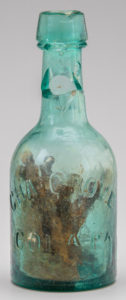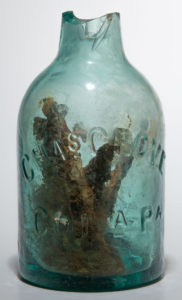 A glass bottle found at a Civil War-era site in York County, Virginia, may be a rare American example of a witch bottle. A team from the William & Mary Center for Archaeological Research (WMCAR) found the bottle in a 2016 excavation of the site of Redoubt 9, now a median between a couple of exits off Interstate 64 near near Busch Gardens, but during the Civil War part of a line of 14 forts that formed the Williamsburg Line.
A glass bottle found at a Civil War-era site in York County, Virginia, may be a rare American example of a witch bottle. A team from the William & Mary Center for Archaeological Research (WMCAR) found the bottle in a 2016 excavation of the site of Redoubt 9, now a median between a couple of exits off Interstate 64 near near Busch Gardens, but during the Civil War part of a line of 14 forts that formed the Williamsburg Line.
An outpost of Fort Magruder, Redoubt 9 was occupied by Union and Confederate forces at different times. When the Williamsburg Line was attacked by the Army of the Potomac in May of 1862, Redoubt 9 was being manned by the 6th South Carolina. They retreated and the Union troops commanded by General Winfield Scott Hancock took all the forts on the line and kept them until the end of the war.
The location of Redoubt 9 was lost over time and highway construction in the 1960s did some damage to the archaeological site. Luckily most of it was under the median, so Redoubt 9 missed the full-scale destruction wrought on either side of it during the digging and paving of the eastbound and westbound lands.
The site was rediscovered as a Civil War battlefield in 2007 by the Virginia Department of Transportation (VDOT), but it wasn’t excavated and confirmed as Redoubt 9 until VDOT wanted to expand the lanes and engaged WMCAR to survey the site in 2016. The dig was surprisingly thorough considering it had to be conducted on a highway median as traffic roared away on both sides of them. They unearthed bullets, 10 fired and 11 unfired, a shrapnel fragment and two bullet cartridges; too thin a result to do any battle mapping. They also found objects attesting to the occupation of the site — buttons, bayonet scabbards, dishes, an empty champagne bottle, a brick-lined hearth, and next to the hearth, a glass beer bottle with a broken neck containing some rusty nails.
The bottle was manufactured by Charles Grove of Colombia, Pennsylvania between the 1840s and 1860s. The 5th Pennsylvania Cavalry occupied Redoubt 9 off and on from May 1862 to August 1863, whenever it looked like battle might be engaged along the Williamsburg Line. They would have been tasked with making any necessary repairs on the fortifications, so at first archaeologists thought the troops had just used an old bottle to hold nails when they reinforced the redoubt.
 Upon further examination, WMCAR researchers now think it might be more than just an impromptu nail holder. Originally an East Anglian folk ritual that was brought to North America by colonists, a witch bottle was made by putting nails or other pointy hardware and anatomical contributions (urine, hair and nail clippings, navel lint) into a bottle and embedding in the wall or burying it under the floor near a hearth or doorway. The bodily detritus lured the witch, the tradition held, and the nails pinned her down. The heat from the hearth increased the power of the bottle’s counter-magic, forcing the witches to break the spell linking them to their victims and even killing the evil-doer.
Upon further examination, WMCAR researchers now think it might be more than just an impromptu nail holder. Originally an East Anglian folk ritual that was brought to North America by colonists, a witch bottle was made by putting nails or other pointy hardware and anatomical contributions (urine, hair and nail clippings, navel lint) into a bottle and embedding in the wall or burying it under the floor near a hearth or doorway. The bodily detritus lured the witch, the tradition held, and the nails pinned her down. The heat from the hearth increased the power of the bottle’s counter-magic, forcing the witches to break the spell linking them to their victims and even killing the evil-doer.
“It’s a good example of how a singular artifact can speak volumes,” [WMCAR director Joe] Jones said. “It’s really a time capsule representing the experience of Civil War troops, a window directly back into what these guys were going through occupying this fortification at this period in time.” […]
Centuries later, there’s no way of knowing for sure if the artifact is a charm against evil spirits or just a bottle full of nails. Jones explained that most witch bottles contain relics of those who buried them. The afflicted would add nail clippings, locks of hair and even urine to witch bottles. The bottle recovered at Redoubt 9 was broken at the top, so Jones said it’s practically impossible to know who made it or what their real intentions were.
“Perhaps the nails in the bottle were put there not by enlisted men using the bottle as an expedient container, but instead by an officer who felt especially threatened occupying hostile territory,” Jones said. “Given the perceived threat of Confederate attack and general hostility of local residents, he had good reason to pull all the stops and rely on folk traditions from his community in Pennsylvania to help protect his temporary home away from home.”
And not just Pennsylvania. The descendants of European colonists from Maine to Georgia kept the late Medieval tradition alive. But perhaps because they can seem like random containers of old trash, witch bottles are very rarely reported. Almost 200 documented witch bottles have been found Britain, but the number on the record in the United States can be counted on the fingers of two hands.